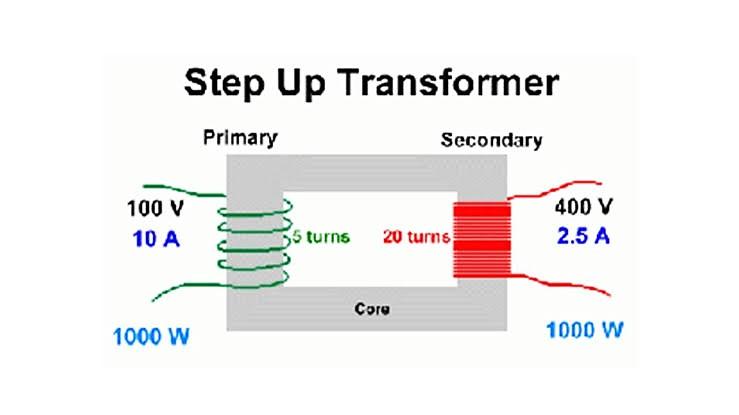Transformer Physics Investigatory Project PDF Class 12

Introduction
The transformer is a device used for converting a low alternating voltage to a high alternating voltage or a high alternating voltage into a low alternating voltage. It is a static electrical device that transfers energy by inductive coupling between its winding circuits. Transformers range in size from a thumbnail-sized coupling transformer hidden inside a stage microphone to huge units weighing hundreds of tons used in power plant substations or to interconnect portions of the power grid. All operate on the same basic principles, although the range of designs is wide. While new technologies have eliminated the need for transformers in some electronic circuits, transformers are still found in many electronic devices. Transformers are essential for high-voltage electric power transmission, which makes long-distance transmission economically practical. A transformer is most widely used device in both low and high current circuit. In a transformer, the electrical energy transfer from one circuit to another circuit takes place without the use of moving parts. A transformer which increases the voltages is called a step-up transformer. A transformer which decreases the A.C. voltages is called a step-down transformer. Transformer is, therefore, an essential piece of apparatus both for high and low current circuits.

Principle
The electric transformer works on the fundamental principle of electromagnetic induction, a concept first discovered by Michael Faraday in the 19th century. The transformer consists of two coils of wire, known as the primary and secondary windings, which are usually wound around a common magnetic core. When an alternating current (AC) flows through the primary winding, it generates a changing magnetic field around the coil. According to Faraday’s law of electromagnetic induction, this changing magnetic field induces an electromotive force (EMF) or voltage in the secondary winding. The key principle here is that the transformer relies on the mutual induction between the primary and secondary windings through the magnetic flux linkage.
Construction
A transformer consists of a rectangular shaft iron core made of laminated sheets, well insulated from one another. Two coils
& and & are wound on the same core, but are well insulated with each other. Note that the both the coils are insulated from the core, the source of alternating e.m.f is connected to , the primary coil and a load resistance R is connected to , the secondary coil through an open switch S. thus there can be no current through the sec. coil so long as the switch is open. For an ideal transformer, we assume that the resistance of the primary & secondary winding is negligible. Further, the energy loses due to magnetic the iron core is also negligible. For operation at low frequency, we may have a soft iron. The soft iron core is insulating by joining thin iron strips coated with varnish to insulate them to reduce energy losses by eddy currents. The input circuit is called primary. And the output circuit is called secondary.

Theory
See PDF for Theory Part
Working
A Transformer based on the Principle of mutual induction according to this principle, the amount of magnetic flux linked with a coil changing, an e.m.f is induced in the neighbouring coil that is if a varying current is set-up in a circuit induced e.m.f. is produced in the neighbouring circuit. The varying current in a circuit produce varying magnetic flux which induces e.m.f. in the neighbouring circuit.
The transformer consists of two coils. They are insulated with each other by insulated material and wound on a common core. For operation at low frequency, we may have a soft iron. The soft iron core is insulating by joining thin iron strips coated with varnish to insulate them to reduce energy losses by eddy currents. The input circuit is called primary. And the output circuit is called secondary.

Efficiency
Efficiency of a transformer is defined as the ratio of output power to the input power i.e.
Thus, in an ideal transformer, where there is no power losses, η = 1. But in actual practice, there are many power losses; therefore, the efficiency of transformer is less than one.
Material Required
- Iron Rod
- Voltmeter
- Ammeter
- Copper wire
Diagram

Procedure
- Take thick iron rod and cover it with a thick paper and wind a large number of turns of thin Cu wire on thick paper (say 60). This constitutes primary coil of the transformer.
- Cover the primary coil with a sheet of paper and wound relatively smaller number of turns (say 20) of thick copper wire on it. This constitutes the secondary coil. It is a step-down transformer.
- Connect p1,p2 to A.C main and measure the input voltage and current using A.C voltmeter and ammeter respectively.
- Similarly, measure the output voltage and current through s1 and s2
- Now connect s1 and s2 to A.C main and again measure voltage and current through primary and secondary coil of step up transformer.
- Repeat all steps for other self-made transformers by changing number of turns in primary and secondary coil.
Observation
- We will find that ratio of and across the two coils is equal to the ratio of number of turns in the coil P to that in the coil S. i.e., Vp/Vs = Np/Ns —————- (1)
- The coil P (to which AC voltage is applied) is called the primary and coil S (in which AC is induced) is called the secondary.
- Since coil S is placed very close to the coil P, the power in the primary is transferred into the secondary through mutual induction.
- It is clear from equation 1, that by appropriate choice of the turn ratio i.e., Np/Ns, we can obtain a higher voltage or lower voltage in S compared to that in P.
Energy Loss
In practice, the output energy of a transformer is always less than the input energy, because energy losses occur due to a number of reasons as explained below.
- Loss of Magnetic Flux: The coupling between the coils is seldom perfect. So, whole of the magnetic flux produced by the primary coil is not linked up with the secondary coil.
- Iron Loss: In actual iron cores in spite of lamination, Eddy currents are produced. The magnitude of eddy current may, however be small. And a part of energy is lost as the heat produced in the iron core.
- Copper Loss: In practice, the coils of the transformer possess resistance. So, a part of the energy is lost due to the heat produced in the resistance of the coil.
- Hysteresis Loss: The alternating current in the coil tapes the iron core through complete cycle of magnetization. So, Energy is lost due to hysteresis.
- Magneto restriction: The alternating current in the Transformer may be set its parts in to vibrations and sound may be produced. It is called humming. Thus, a part of energy may be lost due to humming.
Application of Transformer
- Electric Power Transmission: Transformers are crucial in power transmission networks to step up voltage for efficient long-distance transmission and step-down voltage for distribution to end-users.
- Voltage Regulation: Transformers help maintain a stable voltage level by adjusting the voltage as needed, ensuring consistent and reliable electrical supply.
- Power Distribution: They are used in power distribution systems to provide various voltage levels suitable for residential, commercial, and industrial applications.
- Power Supply Units: Transformers are employed in power supply units of electronic devices, converting AC power from outlets to the DC power needed by devices like computers and chargers.
- Voltage Transformation: Transformers change the voltage levels, allowing electricity to be transmitted at high voltages to reduce energy losses and then be distributed at lower voltages for use.
- Industrial Applications: Transformers power various industrial machinery and equipment by adapting electrical voltage to meet specific operational requirements.
Electrical Appliances: Many electronic devices and appliances use transformers to convert electricity to the required voltage for their operation.
Conclusion
- The output voltage of the transformer across the secondary coil depends upon the ratio (Ns/Np) with respect to the input voltage.
- The output voltage of the transformer across the secondary coil depends upon the ratio (Ns/N p) with respect to the input voltage.
- There is a loss of power between input and output coil of a transformer.

